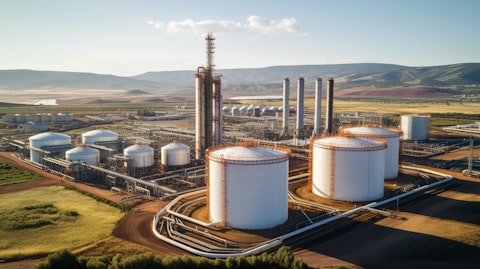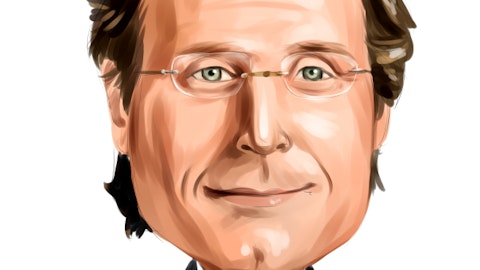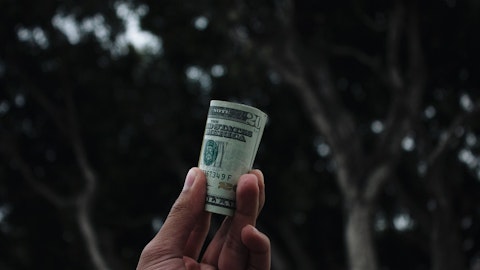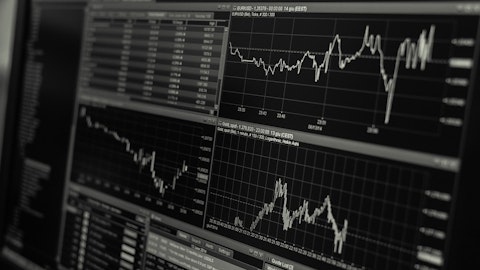Enterprise Products Partners L.P. (NYSE:EPD) Q3 2023 Earnings Call Transcript October 31, 2023
Enterprise Products Partners L.P. misses on earnings expectations. Reported EPS is $0.6 EPS, expectations were $0.63.
Operator: Hello and welcome to Enterprise Products Partners LP Q3 2023 Earnings Conference Call. At this time, all participants are in a listen-only mode. After the speaker’s presentation, there will be a question-and-answer session. [Operator Instructions] I would now like to hand the conference over to Randy Burkhalter, VP of Investor Relations. Sir, you may begin.
Randy Burkhalter: Thank you, Tawanda. Good morning everyone and welcome to the Enterprise Products conference call as we discuss our third quarter earnings. Our speakers today will be Co-Chief Executive Officers of Enterprise’s general partner, Jim Teague and Randy Fowler. Other members of our senior management team are also in attendance for the call today. During this call, we will make forward-looking statements within the meaning of Section 21E of the Securities and Exchange Act of 1934 based on the beliefs of the company, as well as assumptions made by and information currently available to Enterprise’s management team. Although management believes that the expectations reflected in such forward-looking statements are reasonable, it can give no assurance that such expectations will prove to be correct.
Please refer to our latest filings with the SEC for a list of factors that may cause actual results to differ materially from those in the forward-looking statements made during this call. And so, with that, I will turn it over to you Jim.
Jim Teague: Okay, thank you, Randy. This morning we reported solid results for the third quarter including adjusted EBITDA of $2.3 billion. We had 1.7 times coverage of our distributable cash flow and we retained $773 million. But we had challenges throughout the quarter. Record heat in August and September affected our processing plants throughput and refrigeration at our NGL export facilities and we experienced operational challenges at our PDH plants. We were also challenged by low natural gas and NGL prices, but despite these challenges, we handle record volumes across our midstream system, including our liquids pipelines, natural gas pipelines, NGL fractionators and our marine terminals. In total, our pipelines transported 12.2 million barrels per day of crude oil equivalent.
In terms of hydrocarbon exports, we reported 2.1 million barrels a day and while most people focus on crude exports, we focused on hydrocarbon exports. We exported everything from ethylene to crude oil. I think both Randy and I are very optimistic that our folks can do even more with the assets we have. Among some of the highlights so far this year is an unbelievable growing appetite for ethane exports and of course we’re expanding our export facility and this demand seems like it’s comes from all parts of the world. We’re also continuing to see a growing appetite for LPG exports and we’re having productive negotiations in anticipation of getting our SPOT license to construct permits soon. Our fundamentals group forecasts have been consistently on the money in the past.
We have a lot of confidence in their future outlook. Therefore, this morning we announced an expansion of our NGL franchise. We’re going to build two more 300 million cubic feet today processing plants in the Permian, one in the Delaware and one in Midland. When completed, we’ll have 19 processing trains in the Permian and 41 company-wide. Today, we also announced that we are converting our 210,000 barrel per day Seminole crude oil pipeline back to NGL service to support our needed Permian NGL take away. In addition, we announced our Bahia 30-inch NGL pipeline that will originate in the Permian and deliver up to 600,000 barrels a day of NGL into our storage system in Chambers County. The beauty of this Seminole pipeline is we can seamlessly switch service between crude, our NGLs are as an expansion of our new TW refined product system.
Platts Dated Brent: Our focus on quality is extremely important to the entire producer community in order to ensure that Gulf Coast crude remains highly desirable in global markets. We’ve also improved the quality of our Eagle Ford crude oil systems. Not only has it made it easier to sell South Texas wheat, it’s improved the price that we get for that crude. Whether it’s creating new growth projects or improving the performance of assets we have, our folks Enterprise people, continue to deliver strong financial results and we are exceedingly proud of each and every one of them. With that, I’ll turn it over to Randy.
Randy Fowler: Okay, thank you and good morning everyone. Starting with the income statement items, net income attributable to common unit holders for the third quarter of 2023 was $1.3 billion or $0.60 per common unit on a fully diluted basis, compared to $1.4 billion or $0.62 per common unit on a fully diluted basis for the third quarter of last year. Adjusted cash flow from operations or which is cash flow from operating activities before changes in working capital was $2 billion for the third quarters of both 2023 and 2022. We declared a distribution of $0.50 per common unit for the third quarter of 2023, which is a 5.3% increase over the distribution declared for the third quarter of 2022. The distribution will be paid November 14 to common unitholders of record as of close of business today.

This year marks our 25th consecutive year of distribution growth. I guess you can say you can treat that distribution as a treat today. Our dividend reinvestment plan and enterprise unit — employee unit purchase plan purchased approximately 1.4 million common units on the open market for a total purchase price of approximately $37 million during the third quarter of 2023. Our utilization of the authorized $2 billion buyback program is unchanged at 41% with unit purchases for the first nine months of the year totaling approximately 3.6 million common units for a total purchase price of approximately $92 million. For the 12 months ending September 30, Enterprise paid out approximately $4.3 billion in distributions to limited partners. These distributions combined with $213 million in buybacks for the last 12 months result in Enterprise having a payout ratio of adjusted cash flow from operations of 56% and a payout ratio of adjusted free cash flow of 90% for that 12-month period.
Our buyback activity has been admittedly lumpy over the last 18 months. EPD elected not to buy back equity in the third quarter. During the third quarter buyback window our fee WAP, our volume weighted average price was 98% of our 52-week unit price and we elected to be patient. We fully expect to be back in the market doing buybacks in the fourth quarter. We have established a track record of opportunistic buybacks over the last six years. We will continue to look for opportunistic windows to reduce unit count as we remain focused on improving our cash flow per unit metrics. We recently did a comparison of the six largest North American midstream energy companies, those with a market capitalization over $35 billion. Since 2019, EPD is one of only two companies to have actually reduced common unit/share count and we are the only midstream company to reduce unit count over this time period without material asset sales.
EPD reduced its common unit count by approximately 1% over this period, as did our peer. While this is a modest start, it is a consistent start of buybacks for six years in a row. We were also one of only three companies that grew distributable cash flow per unit by 15% or more, in fact, for this group of six midstream energy companies, DPD is the only company to have both reduced unit count and increased DCF per unit. We will include this peer comparison of DCF per unit growth, change in unit count and change in debt in our upcoming investor slide deck after our peers file their third quarter 10-Qs. We believe this will show EPDs balanced approach to increasing the value of the partnership for our limited partners over time. Total capital investments in the third quarter of this year were $826 million which included $722 million for growth projects and $99 million of sustaining cap.
Capital investments for the first nine months of 2023 were $2.3 billion, which includes $2 billion organic growth capital projects and $284 million for sustaining capital expenditures. We expect our 2023 growth capital expenditures to total $3 billion. We expect 2023 sustaining capital expenditures will be approximately $400 million. As Jim mentioned earlier, this morning, we also announced $3.1 billion of organic growth projects to expand our core NGL franchise in the most prolific basin in North America. These projects will provide additional natural gas processing and NGL pipeline and fractionation capacity to support continued production growth out of the Permian Basin. These growth projects will also bring additional volumes to our downstream NGL storage, pipeline and marine terminal assets.
In addition, facilitating Permian production growth also provides indirect business opportunities for our crude oil and natural gas businesses. With the addition of these four projects, we have $6.8 billion of major growth capital expenditures of projects under construction. We are currently forecasting 2024 growth capital expenditures in the range of $3 billion to $3.5 billion. We do not expect this level of capital investment to impact our distribution growth or our buyback activity in 2024. For 2024, we expect our buyback activity to be consistent with our history of approximately $200 million to $250 million a year. We are confident the returns generated by these organic capital investments in the heart of our NGL value chain will support the continued growth in EPD’s cash flow per unit and free cash flow, which will support future returns of capital through both distribution growth and buybacks.
Our total debt principal outstanding was approximately $29.2 billion as of September 30, 2023. Assuming the final maturity date for our hybrids, the weighted average life of our debt portfolio is approximately 19 years. Our weighted average cost of debt is 4.6%. At September 30, approximately 96% of our debt was fixed rate. In 2024 only $850 million or approximately 3% of our $28.6 billion in term debt obligations which excludes commercial paper actually mature. For the three years 2024 through 2026, only 13% of our term debt obligations mature. The combination of this modest maturity ladder, the average life of our debt portfolio and high percentage of fixed rate debt provide the partnership with ample financial flexibility and provides a solid foundation to grow cash flow per unit.
In other words, incremental cash generated from these new projects will not be materially eroded by having to refinance our existing debt portfolio in the current high interest rate environment and thus will better translate into cash flow per unit growth. I do not believe the value of our debt portfolio and liability management is fully appreciated. Our consolidated liquidity was approximately $3.8 billion at the end of the quarter and this includes availability under our credit facilities and unrestricted cash on hand. Our adjusted EBITDA was $9.2 billion for the trailing 12 months ending September 30, 2023 compared to $9 billion for the trailing 12 months ending September 30, 2022. We ended the quarter with a consolidated leverage ratio of 3.0 times on a net basis after adjusting debt for the partial equity treatment of our hybrid debt and reduced by the partnership’s unrestricted cash on hand.
Our leverage target remains 3 times plus or minus 0.25, so the range of 2.75 to 3.25 times. With that Randy, we can open it up for questions.
Randy Burkhalter: Okay, thank you, Randy. Tawanda, we’re ready now to take questions from our participants and I would just remind our participants that please restrict your questions to one question and one follow up. Okay? Thank you. Tawanda, go ahead.
Operator: Thank you. [Operator Instructions] Our first question comes from the line of Theresa Chen with Barclays. Your line is open.
See also 16 Best EV Stocks Under $50 and 12 Best UK Stocks To Buy Now.
Q&A Session
Follow Enterprise Products Partners L.p. (NYSE:EPD)
Follow Enterprise Products Partners L.p. (NYSE:EPD)
Theresa Chen: Good morning. Thank you for taking my questions. Would you mind providing some more color about what drove the magnitude of the project FIDs at this specific juncture? What changed versus previous expectations, the annual growth CapEx cadence and were some of these projects contemplated earlier in that $2 billion to $2.5 billion CapEx range, but things got more expensive or they are discrete projects that previously weren’t in your runway not been brought in?
Randy Fowler: I guess what changed is the opportunities were there, Theresa and we thought like it is the right time to go. I know there’s a lot of questions in the past on Chinook and as we look at what we’re doing out in the Permian, we felt like we needed to move on Chinook given that we’re going to build two more plants and bringing our plants out there to 19, which is quite a lot of WAG, right? Chris?
Christian Nelly: Yes, Theresa, this is Chris Nelly. You know, I think what we’ve been talking about on the last quarter’s earnings call was that, we were looking for what was the most effective way to expand our NGL take away capacity out of the basin. And as Jim alluded to with some of the commercial successes we’ve had in expanding and winning contracts on gas processing capacity, we came to the conclusion that we needed to build the full Bahia pipeline and as a result of that downstream of that you need additional frac capacity. So in our minds that these things go very much hand in hand and it is in the core of our NGL franchise.
Randy Fowler: And as evidence to that Theresa, we took Seminole’s crude service because we need NGL take away right now until the Bahia pipeline gets in service. So Frac #14 will be full and those two processing plants when we bring them on will be full, right Natalie?
Theresa Chen: Got it. Would you also be able to provide an update on the commercialization progress for SPOT? And would it be possible to maybe move some or all of the ECHO export volumes over to SPOT, maybe supplementing that commercialization effort, if anything? And that would make space, I imagine for incremental NGL exports given that you do see a tremendous amount of NGL growth across your system underlying your project announcement today, which includes expansions nearly along every aspects of your NGL infrastructure value chain except exports?
Randy Fowler: Yes, we’re going to, we’re having some productive negotiations with producers and large trading houses on SPOT and frankly I’m getting more optimistic by the day. We have that record of decision. We’re still waiting on Bob Sanders, the license to construct which we’re hoping that we expect to have by the end of the year.
Robert Sanders: We’re continuing to work with Mayor Ed and the Department of Transportation on moving that forward, so timing is relatively short, yes, Sir.
Randy Fowler: You got anything, Brent?
Brent Secrest: No I think overall the momentum on SPOT, it continues to get better and better and the earlier question, this question to me it’s what do we believe as a company. I think Tony Chovanec and his group need to take a victory lap for their ability to forecast production and SPOT is going to be about what the Permian Basin does from crude oil and all things and that’s what all these projects align toward.
Randy Fowler: And on to the question on more LPG out of the ship channel, I think everybody knows how much I love the Houston Ship Channel. And the neat thing about the ship, the ship channel is you have two-way traffic. From what I understand daylight restrictions will be lifted November 1st, but then when they widen it that’s even — we can get a lot more traffic coming down that channel, Bob?
Robert Sanders: Yes Sir, that’s absolutely correct. The wider channel is going to allow us to move more product, whether it’s LPGs or crude oil or ethane.
Theresa Chen: Got it. Thank you.
Operator: Thank you. Please stand by for the question. Our next question comes from the line of Jeremy Tonet with JPMorgan Securities. Your line is open.
Jeremy Tonet: Hi, good morning.
Randy Fowler: Good morning.
Jeremy Tonet: I just want to come back to capital allocation. I appreciate the deep commentary in the prepared remarks there, but just wanted to kind of come in overlaying once, once these projects tend to service the projects announced today, Enterprise appears well positioned to generate significantly more free cash flow and drop leverage well below three times here it seems. I believe your messaging highlights the ability to return more cash to investors with these projects and maybe could you talk us through how you see Enterprise’s capital allocation unfolding and particularly given the potential for lumpiness as you described?
Jim Teague: Yes Jeremy, I think we’ve demonstrated as far as coming in and consistently, and I’d like to say we balanced the buybacks with continuing to invest in the partnership and grow cash flows per unit. And to me the cash flow per unit growth is the main metric there and leverage. And keeping leverage in check are the — is really the main metric because the more cash flow per unit you grow eventually this is going to translate into free cash flow, because again, I think our growth CapEx is lumpy over time. We, in 2024 we said we were going to be back in the range of 3 to 3.5 times and some of that is, we have a number of projects. I keep hating to use the word lumpy, but we have some material projects out there whether it’s our [indiscernible] river, export our ethane and propane export facility or whether it’s the Bahia pipeline that are fairly large projects.
Once you get past those, the natural gas processing plants, NGL fractionators are very manageable growth CapEx. SPOT would be out there, if we cannot go ahead and finish commercializing that, but that’s something that’s going to be spread out over 3, 3.5 years. So I really see the period where we’re investing the $3 billion to $3.5 billion a year is pretty limited and so as a result I think once you get out further call it 2025, 2026, 2027, we ought to be flowing off a good bit of free cash flow as you say. Right now, we don’t see the need to come in and reduce leverage anymore from where we are today with the target of 3.3 times. So again, that provides more cash for distribution growth and buybacks.
Jeremy Tonet: Got it. That’s very helpful there. Thanks. And then just want to pivot back to the projects announced today a little bit more, if I could. And clearly the growing logistics needs associated with robust Permian production is the focal point for midstream here highlighted by your announcement today. And so diving in a little bit more here on the NGL pipe side specifically with today’s announcement and the NGL pipe additions appear to outpace I guess the 1.2 million of NGL production growth enterprise 2030, if you look at all the NGL pipes I think talked about in the industry and granted Enterprise has acres dedication and a closed loop system which provides barriers to entry there. But do you see risk to a looser NGL pipeline market down the road and how did Enterprise I guess gain comfort in this size of an NGL pipe?




